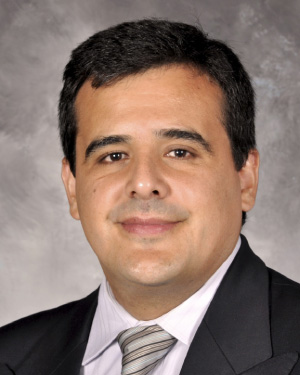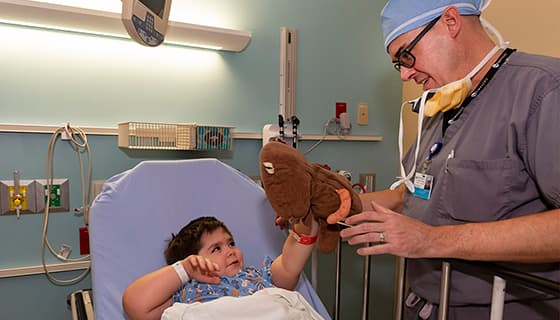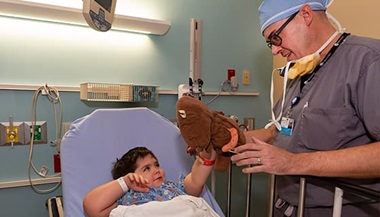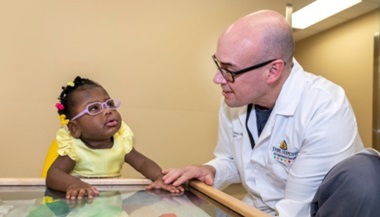Patient Story
Bronchopulmonary Dysphasia: Jahleel’s Story
Patient Story Highlights
- Jahleel was born prematurely at 24 weeks gestation, weighing 1 pound, 11 ounces.
- He had a chronic lung disease called bronchopulmonary dysplasia (BPD), which is common in premature babies.
- A specialized team at Johns Hopkins All Children’s Hospital cares for patients with complex esophageal and airway anomalies.
- Surgical procedures repaired Jahleel’s collapsing airway, allowing him to recover and go home.
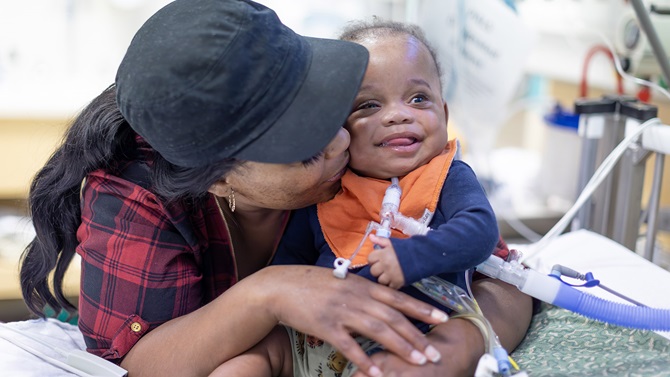
Jahleel and his mom Josett at Johns Hopkins All Children's
Jahleel’s family had a lot to celebrate when his family took him to get a professional photo for his first birthday recently. Technically, he wasn’t due to arrive until May 2023. But after his mother suffered a variety of medical complications, including a serious blood pressure condition called preeclampsia, she was forced to deliver him early, changing his arrival date to Jan. 17, at only 24 weeks gestation and weighing 1 pound, 11 ounces.
“The doctors told me my blood pressure was on the verge of causing me to have a stroke,” says Josett, his mother. “For my safety, the doctors said they needed to deliver the baby.”
Due to the anticipated complications that come with any premature newborn, Jahleel was quickly transferred from Bayfront Baby Place (part of Bayfront Health St. Petersburg but located within Johns Hopkins All Children’s Hospital) to the neonatal intensive care unit (NICU), which has a Level IV ranking, the highest available from the American Academy of Pediatrics.
Diagnosed withBronchopulmonary Dysphasia
Jahleel was suffering from a chronic lung disease called bronchopulmonary dysplasia (BPD), a condition not uncommon in babies born prematurely. Because of the need for mechanical ventilation and oxygen therapy, he was intubated with a breathing tube through his mouth. He also later received a tracheostomy (a surgical procedure that creates an opening in the neck and into the windpipe). This opening allows air to bypass the nose and mouth and enter the lungs directly through a tube inserted into the trachea. This is a common strategy for babies that require prolonged mechanical ventilation (use of a breathing machine).
To complicate matters, he was struggling with pulmonary hypertension. The condition is common for premature infants with these types of medical issues.
In the NICU, Josett and her husband, Jamole, held Jahleel in their arms, while he was connected to numerous wires and tubes that were helping keep him alive. His tiny airway was so unstable it collapsed several times, causing setbacks on his road to recovery. Doctors had set his ventilator on the highest level possible to help with stabilization.
Specialized Care
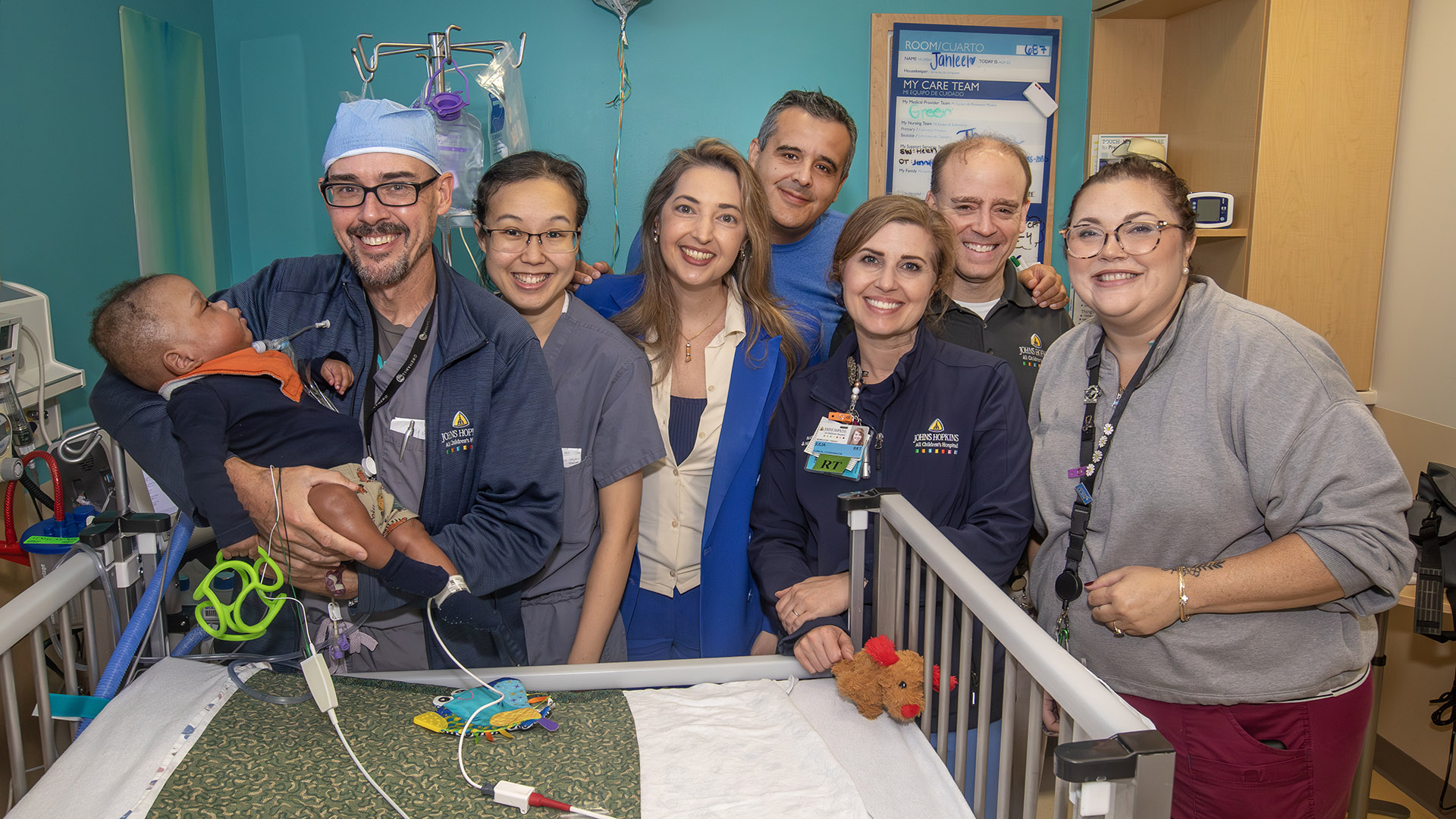 Jahleel with his care team at Johns Hopkins All Children's
Jahleel with his care team at Johns Hopkins All Children'sThe Esophageal and Airway Treatment (EAT) team at Johns Hopkins All Children’s Hospital stepped in to help. Led by a pediatric thoracic surgeon, Jason Smithers, M.D., this multidisciplinary team cares for patients with complex esophageal and airway anomalies, drawing patients from around the United States and other countries. Patients are treated using a team approach with providers from various specialties, including pediatric surgeons, gastroenterologists, otolaryngologists, pulmonologists, critical care physicians, nutritionists and speech/swallowing specialists.
“Jahleel’s lung issues were on the more severe side of the cases we see,” Smithers says. “Since prematurity effects these babies head to toe, you have to look at the details of every bodily system and involve specialists for those systems in order to figure out how to optimize their care.”
The EAT team performed both a tracheopexy and aortopexy, surgical procedures used to open and support the airway, to help him breathe better and allow his ventilator settings to be turned down to a safer level. These operations are designed to improve tracheomalacia, a condition where the trachea, or windpipe, becomes weak and collapses, causing difficulty breathing, wheezing and even respiratory failure.
“The trachea is opened up by moving the parts of the airway that collapse, and we suture it to the structures around it to pin the airway open and keep it stable to prevent it from collapsing,” Smithers says.
“Jahleel started to improve right away,” Josett says. “The doctors told me that they didn’t expect him to get better as fast as he did.”
“All of these kids are complicated, because prematurity affects all their body systems, lungs, heart and brain,” Smithers says. “If you have to do surgery, you have to figure out how to do that safely in the context of any of the other issues impacting the baby.”
Going Home
Finally, after nine months in the hospital, Jahleel got to go home for the first time on Oct. 31.
Josett, a certified nursing assistant (CNA), says she is used to being in a medical environment. However, she only works with adults. “Dealing with Jahleel’s issues are different when it’s your own child,” she says. “I had to make sure I understood all his medical issues and how I need to care for him at home.”
Today, Jahleel weighs more than 17 pounds. “He’s doing great,” Josett says. “He has hit a few bumps in the road since he was discharged in October. We have been back to the hospital a couple of times.
“But he has started doing things that are normal for a 1-year-old. He loves playing with his brothers. He laughs a lot. He’s a happy baby. I’m starting to see light at the end of the tunnel for him and healthy days ahead.”



